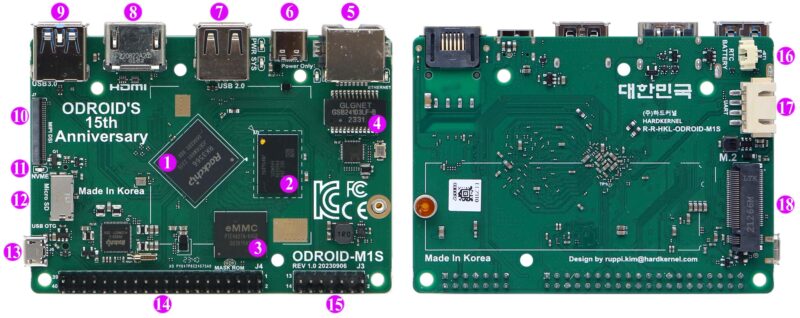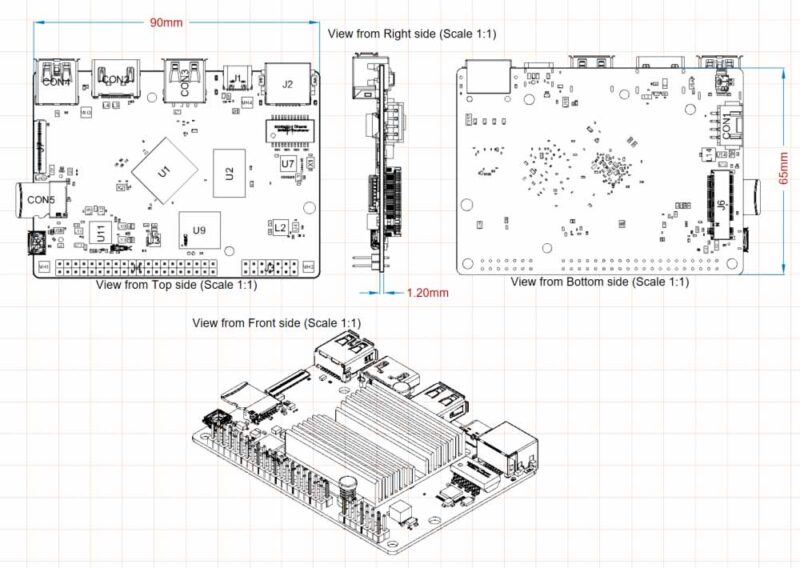
Empowering Your Home Automation Journey: Introducing the ODROID M1S with Home Assistant
The ODROID M1S with Home Assistant represents a leap forward in home automation technology. Designed for enthusiasts and DIY enthusiasts alike, this all-in-one starter package provides the tools you need to create a smart home ecosystem tailored to your preferences.
Key Features:
- Home Assistant Framework: At the heart of the ODROID M1S is the Home Assistant open-source framework. With a strong emphasis on local control and privacy, Home Assistant allows you to manage all your compatible household devices seamlessly. Imagine Apple Homekit, but with even greater flexibility and customization.
- Community-Powered: Join a global community of tinkerers and innovators. Home Assistant thrives on collaboration, ensuring continuous improvement and a wealth of integrations.
Comprehensive Kit Contents:
- Odroid M1S: The central computing unit, meticulously designed for optimal performance. Notably, the M1S board is 20% thinner than its predecessors, resulting in a sleeker profile.
- Power Supply: A reliable power source ensures uninterrupted operation.
- Black Case: Not just functional, but also aesthetically pleasing, the black case protects your components.
- Preinstalled Home Assistant Operating System: Get started right away with the Home Assistant OS ready to go.
!ODROID M1S with Home Assistant
Enhanced Hardware:
- Built-in 64GB eMMC Chip: The M1S board features an integrated 64GB eMMC chip, streamlining storage and enhancing stability.
- Reduced Power Consumption: Enjoy energy efficiency without compromising performance.
- Sturdy Design: The M1S board ensures reliable operation, making it ideal for long-term use.
Whether you’re automating lighting, climate control, security, or entertainment, the ODROID M1S with Home Assistant empowers you to create an affordable and sustainable smart home ecosystem.
Empowering Your Home Automation Journey: Introducing the ODROID M1S with Home Assistant
The ODROID M1S with Home Assistant represents a leap forward in home automation technology. Designed for enthusiasts and DIY enthusiasts alike, this all-in-one starter package provides the tools you need to create a smart home ecosystem tailored to your preferences.
Key Features:
- Home Assistant Framework: At the heart of the ODROID M1S is the Home Assistant open-source framework. With a strong emphasis on local control and privacy, Home Assistant allows you to manage all your compatible household devices seamlessly. Imagine Apple Homekit, but with even greater flexibility and customization.
- Community-Powered: Join a global community of tinkerers and innovators. Home Assistant thrives on collaboration, ensuring continuous improvement and a wealth of integrations.
Comprehensive Kit Contents:
- Odroid M1S: The central computing unit, meticulously designed for optimal performance. Notably, the M1S board is 20% thinner than its predecessors, resulting in a sleeker profile.
- Power Supply: A reliable power source ensures uninterrupted operation.
- Black Case: Not just functional, but also aesthetically pleasing, the black case protects your components.
- Preinstalled Home Assistant Operating System: Get started right away with the Home Assistant OS ready to go.
!ODROID M1S with Home Assistant
Enhanced Hardware:
- Built-in 64GB eMMC Chip: The M1S board features an integrated 64GB eMMC chip, streamlining storage and enhancing stability.
- Reduced Power Consumption: Enjoy energy efficiency without compromising performance.
- Sturdy Design: The M1S board ensures reliable operation, making it ideal for long-term use.
Whether you’re automating lighting, climate control, security, or entertainment, the ODROID M1S with Home Assistant empowers you to create an affordable and sustainable smart home ecosystem.
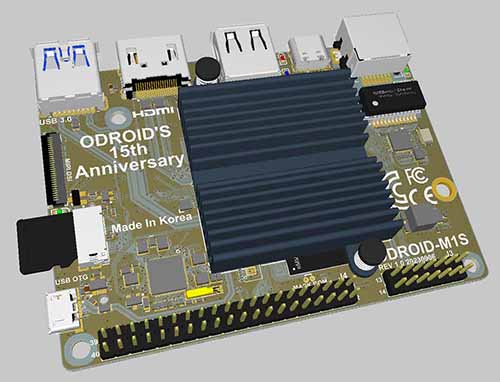 | 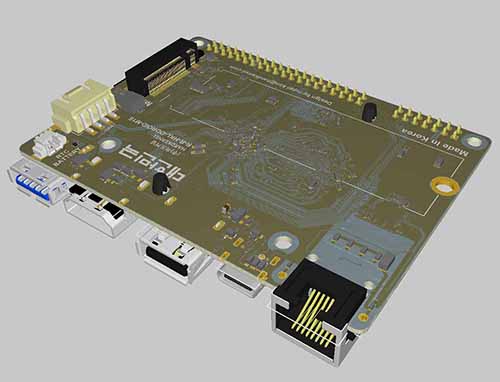 |
| Top of Board with I/O Pins | Bottom of Board with I/O Pins |
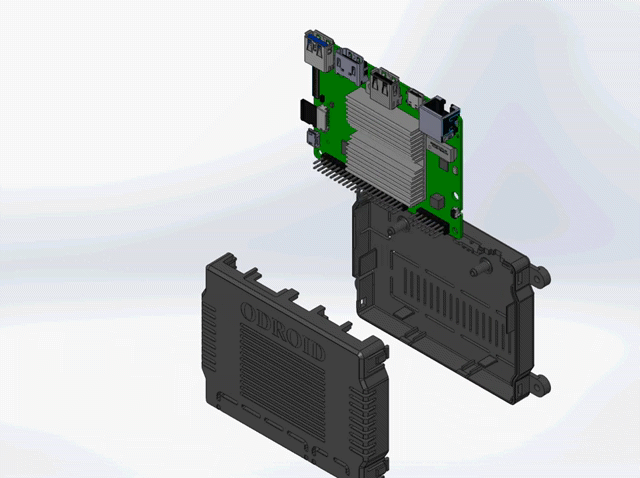
On-Board eMMC Storage
For the first time in the ODROID board series, an eMMC chip was soldered to the PCB by default instead of using a removable eMMC module. We think 64GB capacity is sufficient for building most embedded systems.
The speed of eMMC measured with the I/O command is approximately 180MiB/s, which is about 3~5 times faster than typical microSD cards.
On-board M.2 NVMe slot
In case the 64GB storage space of the soldered eMMC memory is insufficient, consider using an industry standard 2280 form factor NVMe SSD. An on-board M.2 NVMe slot is provided to access large amounts of data storage.
Unlike the original M1 model’s PCIe 3.0 x 2 lanes configuration, M1S has PCIe 2.1 x 1 lane. The NVMe transfer speed of the M1S has been reduced by about 1/4. However, we still believe that ~400 MiB/s of storage access speed is sufficient for building various high-end embedded systems.
Note that M.2 SATA storage devices can not be used. The M.2 slot supports only a PCIe interface (M-Key).
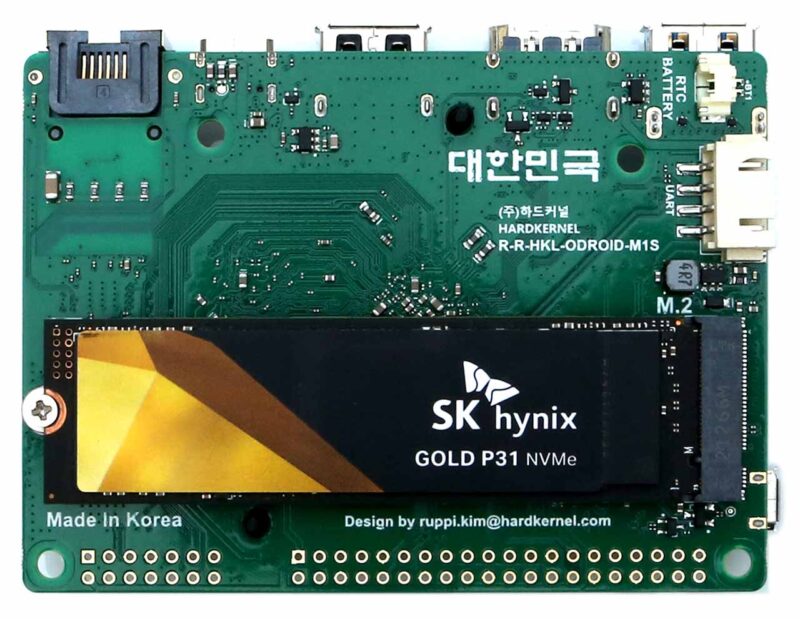 |
Board Detail
1 Rockchip RK3566 CPU | 10 1 x MIPI DSI 4Lane |
2 LPDDR4 RAM | 11 1 x M.2 LED Indicator |
3 1 x 64GB eMMC embedded | 12 1 x Micro SD Slot |
4 1 x Ethernet Transformer | 13 1 x Micro USB2.0 OTG |
5 1 x RJ45 Ethernet Port (10/100/1000) | 14 40 x GPIO Pins Optional |
6 1 x USB Type C Power Connector | 15 14 x GPIO Pins Optional |
7 1 x USB 2.0 | 16 1 x RTC Backup Battery Connector |
8 1 x HDMI 2.0 | 17 1 x UART for System Console |
9 1 x USB 3.0 | 18 1 x M.2. M-KEY PCIe2.1 1Lane |
FORM FACTOR | Board Dimensions: 90mm x 65mm x 16mm |
PROCESSOR | Rockchip RK3566 Processor |
NPU | 0.8 TOPS@INT8, Integrated AI accelerator RKNN NPU |
STORAGE | 1 x 64GB eMMC embedded (soldered to the PCB) |
NETWORKING | 1 x GbE LAN ports (RJ45, supports 10/100/1000 Mbps) |
VIDEO | 1 x HDMI 2.0 (up to 4K@60Hz with HDR, EDID) |
EXTERNAL I/O | 1 x USB 2.0 host port |
OTHER FEATURES | RTC backup battery connector (to keep time and date for several months without main power input) |
POWER | 1 x USB Type C for Power |
GPIO Header
There are 40-pin and 14-pin header pin connectors for general purpose input and output functions. Digital IOs, UARTs, I2Cs, PWMs, ADCs, SPI, USB 2.0 host, Analog audio output, Power-on and Reset signals are available.
What we heard from many B2B and B2C customers is that they often didn’t use the actual GPIO functionality. Therefore, to lower production costs and product price, we decided to make GPIO header pin installation an option. If you choose the option to install 40-pin and 14-pin GPIO headers, $3 will be added to the price. An IO-labels board for easier DIY tinkering will also be provided.
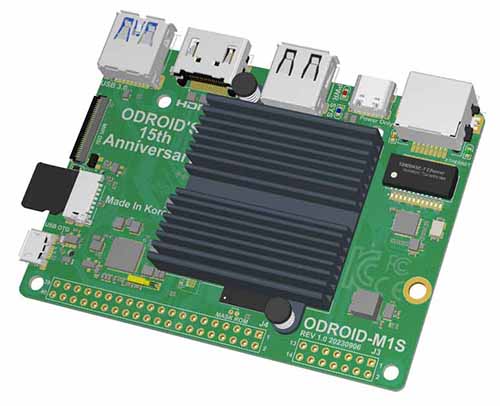 | 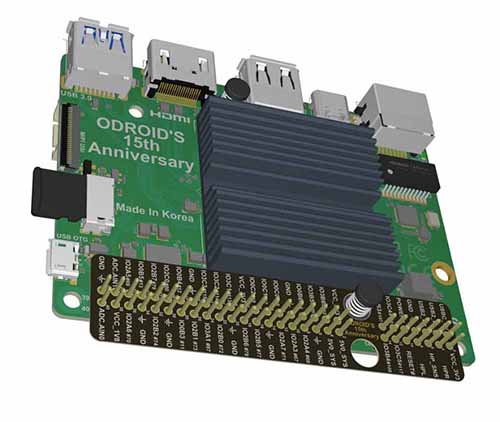 |
MIPI-DSI
-The four-lane MIPI-DSI port can be directly connected to an LCD panel.
-The ODROID-Vu8S kit with an 8 inch, 800×1280 wide viewing angle LCD and capacitive multi-touch screen is an available option. Note that LCD connector is different from the one on the ODROID-M1.
-If you assemble the ODROID-M1S single board computer on the rear side of the Vu8S kit, you can easily implement a Human-Machine-Interface (HMI) device with Android as well as Linux.
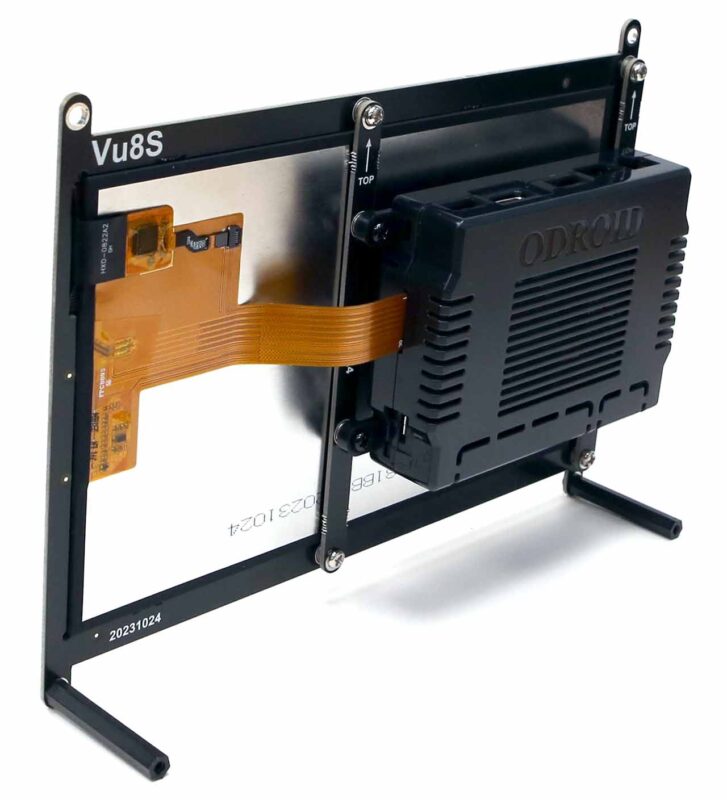 | 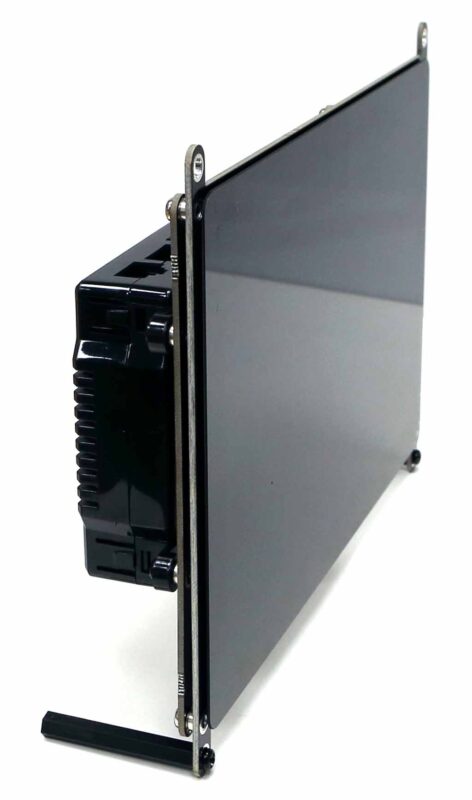 |
 |
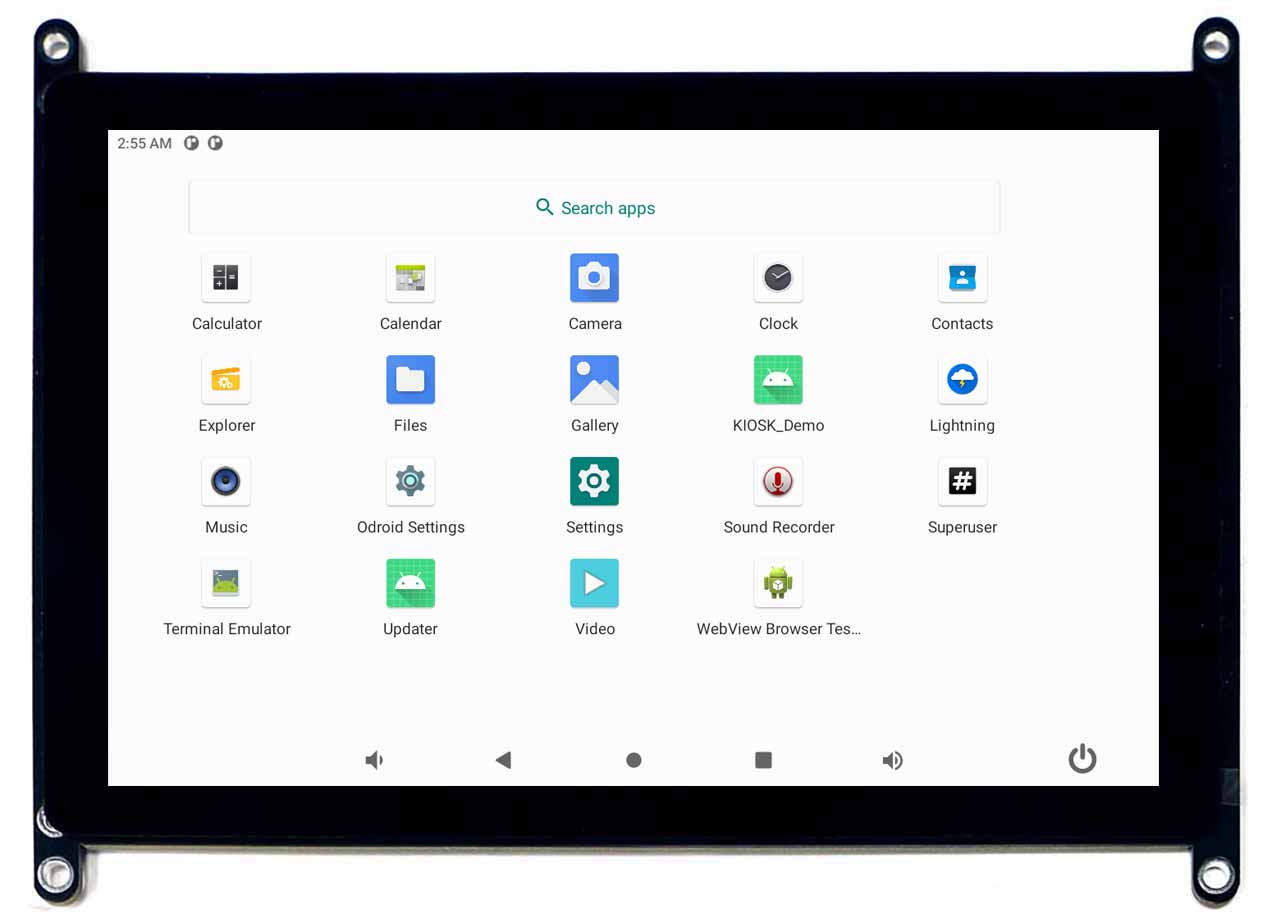 |
NPU
Since Machine Learning has been a trend in this industry, there is a neural network processing unit (NPU) which can deliver up to 0.8 TOPS on the M1S single board computer.
We could run various TensorFlow Lite and ONNX models on Ubuntu Linux OS. Here is an example of object detection.
– Input image and Output image ( The input image source : https://commons.wikimedia.org/wiki/File:Traffic_in_Brasilia_before_Brazil_%26_Chile_match_at_World_Cup_2010-06-28_1.jpg )
As shown in the test results below, the object detection speed of the NPU is nearly 20 times faster than that of the CPU. For reference,
the NPU performance of M1S is about 10% lower than that of M1. We believe this is due to the difference in DRAM clocks.
Conf=0.25 CPU (ms) NPU (ms) NPU: Cam (fps)
M1S 1288.3 70 11.8
M1 1225.7 64.3 13
CPU governor = performance
AI model = yolov5s.onnx(cpu) / yolov5s.rknn(npu)
Confidence threshold = 0.25
USB Camera = Logitech BRIO
 |  |
Software Support
Android 11
- AOSP based on Rockchip BSP
- Customized raw GPIO access framework : Android Things with various examples https://wiki.odroid.com/common/android_things
- GPIO toggling
- Rotary encoder with GPIO IRQ
- PWM outputs
- I2C (Color sensor, Temperature, Humidity, OLED, RTC)
- SPI ( CAN receiver, LED strip lights, IO expander)
- UART ( Loopback test, Barcode scanner, Thermal printer)
- GPIO toggling
- Rotary encoder with GPIO IRQ
- PWM outputs
- I2C (Color sensor, Temperature, Humidity, OLED, RTC)
- SPI ( CAN receiver, LED strip lights, IO expander)
- UART ( Loopback test, Barcode scanner, Thermal printer)
Ubuntu 20.04 LTS
- Kernel 5.10.160
- Wayland based GNOME desktop
- ARM Mali Bifrost GPU OpenGL-ES / EGL driver
- MIPI DSI driver
- GPIO drivers and WiringPi library
- NPU driver and Neural Network APIs
- VPU driver with MPP/Gstreamer APIs
Ubuntu 22.04 LTS
- Kernel 6.1.60
- Wayland based Gnome/KDE desktop
- ARM Mali Panfrost GPU driver for desktop OpenGL 3.x
- MIPI DSI driver
- GPIO drivers and WiringPi library
Representative Application Examples and Videos
M1S + 6 channel stepper motor board and actual 3D printer operation video (via YouTube)
M1S + 4 Channel Relay board controlling a home system.
Documentation
We provide comprehensive documentation for nearly 100 items through our WiKi pages and Github.
- Features of the OS images and installation guides for Ubuntu, Android, ROS2 and so on
- Hardware: Specification, Full schematics, Datasheet, 3D models, Add-on board PCB design template for KiCad and over 10 add-on peripherals
- Software Board-Support-Package : Boot-loader, Kernel, Partition table, How-to-build, Boot-sequence, USB-UART console debugging and so on
- Application Notes : Device-Tree Overlay, WiringPi and Python libraries for GPIO, Basic GPIO access, ADC, UART, PWM, I2C, LCD, Sensors, SPI, CAN-Bus, 1-Wire, How-to use NPU accelerator for AI application, How-to use VPU for video decoding and encoding, How to use MIPI-DSI interface with 5 inch or 8 inch MIPI LCD.
ODROID M1S With Home Assistant - 4GB RAM [10021]
- Brand: Hard Kernel
- Product Code: ODROID M1S With Home Assistant - 4GB RAM
- Availability: In Stock
-
78.57€
- Ex Tax: 64.40€

![ODROID M1S With Home Assistant - 4GB RAM [10021] ODROID M1S With Home Assistant - 4GB RAM [10021]](https://www.odroid.nl/image/cache/catalog/M1S/Home Assistant/M1S-HA-Case-228x228.jpg)
![ODROID M1S With Home Assistant - 4GB RAM [10021] ODROID M1S With Home Assistant - 4GB RAM [10021]](https://www.odroid.nl/image/cache/catalog/M1S/M1S_GPIO-No-Header-Board-74x74.jpg)
![ODROID M1S With Home Assistant - 4GB RAM [10021] ODROID M1S With Home Assistant - 4GB RAM [10021]](https://www.odroid.nl/image/cache/catalog/M1S/M1S_GPIO2-Header-Board-74x74.jpg)
![ODROID M1S With Home Assistant - 4GB RAM [10021] ODROID M1S With Home Assistant - 4GB RAM [10021]](https://www.odroid.nl/image/cache/catalog/M1S/M1SNVMe View-800x619-74x74.jpg)
